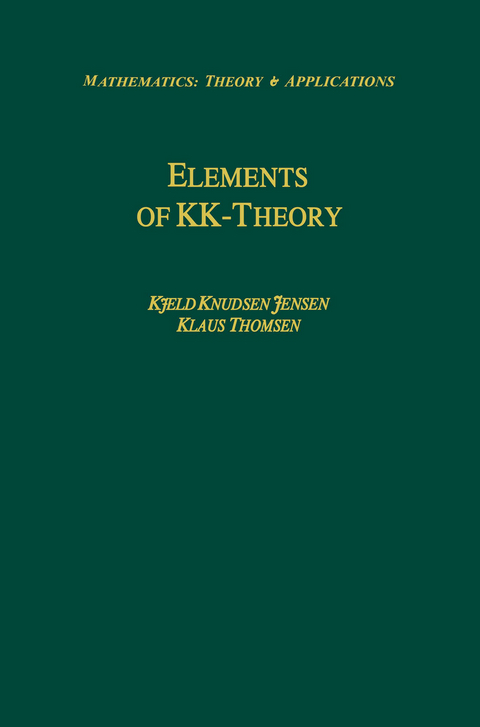
Elements of KK-Theory
Seiten
2012
|
Softcover reprint of the original 1st ed. 1991
Humana Press Inc. (Verlag)
978-1-4612-6765-2 (ISBN)
Humana Press Inc. (Verlag)
978-1-4612-6765-2 (ISBN)
The KK-theory of Kasparov is now approximately twelve years old; Nonethe less, it remains a forbiddingly difficult topic with which to work and learn. Finally, the subject itself has come to consist of a number of difficult segments, each of which demands prolonged and intensive study.
The KK-theory of Kasparov is now approximately twelve years old; its power, utility and importance have been amply demonstrated. Nonethe less, it remains a forbiddingly difficult topic with which to work and learn. There are many reasons for this. For one thing, KK-theory spans several traditionally disparate mathematical regimes. For another, the literature is scattered and difficult to penetrate. Many of the major papers require the reader to supply the details of the arguments based on only a rough outline of proofs. Finally, the subject itself has come to consist of a number of difficult segments, each of which demands prolonged and intensive study. is to deal with some of these difficul Our goal in writing this book ties and make it possible for the reader to "get started" with the theory. We have not attempted to produce a comprehensive treatise on all aspects of KK-theory; the subject seems too vital to submit to such a treatment at this point. What seemed more important to us was a timely presen tation of the very basic elements of the theory, the functoriality of the KK-groups, and the Kasparov product.
The KK-theory of Kasparov is now approximately twelve years old; its power, utility and importance have been amply demonstrated. Nonethe less, it remains a forbiddingly difficult topic with which to work and learn. There are many reasons for this. For one thing, KK-theory spans several traditionally disparate mathematical regimes. For another, the literature is scattered and difficult to penetrate. Many of the major papers require the reader to supply the details of the arguments based on only a rough outline of proofs. Finally, the subject itself has come to consist of a number of difficult segments, each of which demands prolonged and intensive study. is to deal with some of these difficul Our goal in writing this book ties and make it possible for the reader to "get started" with the theory. We have not attempted to produce a comprehensive treatise on all aspects of KK-theory; the subject seems too vital to submit to such a treatment at this point. What seemed more important to us was a timely presen tation of the very basic elements of the theory, the functoriality of the KK-groups, and the Kasparov product.
1. Hilbert C*- Modules.- § 1.1. Hilbert C*-Modules and Multiplier Algebras.- § 1.2. Constructions with Hilbert B-Modules.- § 1.3. Stable C*-Algebras.- 2. The Kasparov Approach to KK-Theory.- § 2.1. The KK-Groups.- § 2.2. The Kasparov Product.- 3. C*-Extensions.- § 3.1. The Busby Invariant.- § 3.2. The Extension Groups.- § 3.3. Connections to KK-Theory.- 4. The Kasparov Groups for Ungraded C*-Algebras.- § 4.1. From Hilbert C*-Modules to *-Homomorphisms.- § 4.2. Split-Exactness of KKh.- § 4.3. The Kasparov Product as a Generalization of Composition of *-Homomorphisms.- 5. Cuntz’s Picture of KK-Theory.- § 5.1. qA.- § 5.2. KKc(A, B) ? KKo(A, B).- References.
| Reihe/Serie | Mathematics: Theory & Applications |
|---|---|
| Zusatzinfo | VIII, 202 p. |
| Verlagsort | Totowa, NJ |
| Sprache | englisch |
| Maße | 155 x 235 mm |
| Themenwelt | Mathematik / Informatik ► Mathematik ► Allgemeines / Lexika |
| Mathematik / Informatik ► Mathematik ► Algebra | |
| Mathematik / Informatik ► Mathematik ► Geometrie / Topologie | |
| ISBN-10 | 1-4612-6765-X / 146126765X |
| ISBN-13 | 978-1-4612-6765-2 / 9781461267652 |
| Zustand | Neuware |
| Informationen gemäß Produktsicherheitsverordnung (GPSR) | |
| Haben Sie eine Frage zum Produkt? |
Mehr entdecken
aus dem Bereich
aus dem Bereich
Buch | Hardcover (2023)
Hanser, Carl (Verlag)
CHF 41,95
Geschichten aus der europäischen Mathematik der Neuzeit
Buch | Softcover (2024)
Springer (Verlag)
CHF 41,95


